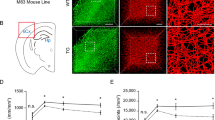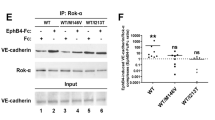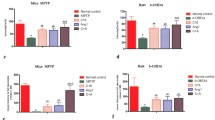Abstract
Spinocerebellar ataxia type 1 (SCA1) is an adult-onset, dominantly inherited neurodegenerative disease caused by expansion of a glutamine repeat tract in ataxin-1 (ATXN1). Although the precise function of ATXN1 remains elusive, it seems to be involved in transcriptional repression. We find that mutant ATXN1 represses transcription of the neurotrophic and angiogenic factor vascular endothelial growth factor (VEGF). Genetic overexpression or pharmacologic infusion of recombinant VEGF mitigates SCA1 pathogenesis, suggesting a new therapeutic strategy for this disease.
This is a preview of subscription content, access via your institution
Access options
Subscribe to this journal
Receive 12 print issues and online access
$209.00 per year
only $17.42 per issue
Buy this article
- Purchase on Springer Link
- Instant access to full article PDF
Prices may be subject to local taxes which are calculated during checkout


Similar content being viewed by others
References
Lin, X., Antalffy, B., Kang, D., Orr, H.T. & Zoghbi, H.Y. Nat. Neurosci. 3, 157–163 (2000).
Serra, H.G. et al. Hum. Mol. Genet. 13, 2535–2543 (2004).
Gatchel, J.R. et al. Proc. Natl. Acad. Sci. USA 105, 1291–1296 (2008).
Orr, H.T. & Zoghbi, H.Y. Annu. Rev. Neurosci. 30, 575–621 (2007).
Tsai, C.C. et al. Proc. Natl. Acad. Sci. USA 101, 4047–4052 (2004).
Watase, K. et al. Neuron 34, 905–919 (2002).
Oosthuyse, B. et al. Nat. Genet. 28, 131–138 (2001).
Lambrechts, D. & Carmeliet, P. Biochim. Biophys. Acta 1762, 1109–1121 (2006).
Sopher, B.L. et al. Neuron 41, 687–699 (2004).
Ruiz de Almodovar, C. et al. J. Neurosci. 30, 15052–15066 (2010).
Acker, T., Beck, H. & Plate, K.H. Mech. Dev. 108, 45–57 (2001).
Burright, E.N. et al. Cell 82, 937–948 (1995).
Ramanathan, M., Pinhal-Enfield, G., Hao, I. & Leibovich, S.J. Mol. Biol. Cell 18, 14–23 (2007).
Fernandez-Funez, P. et al. Nature 408, 101–106 (2000).
Chen, H.K. et al. Cell 113, 457–468 (2003).
Wang, Y. et al. Brain 128, 52–63 (2005).
Oz, G. et al. Mov. Disord. 25, 1253–1261 (2010).
Lim, J. et al. Cell 125, 801–814 (2006).
Acknowledgements
We thank H. Zoghbi (Baylor College of Medicine) and H. Orr (University of Minnesota) for generously providing ATXN1 constructs and the SCA1 mouse models, and S. Leibovich (University of Medicine and Dentistry of New Jersey) and P. D'Amore (Harvard Medical School) for VEGF luciferase reporter constructs. We also thank K. Gobeske for assistance with the intracerebroventricular delivery methods, A. Ma for help with pathological analyses and V. Brandt for editorial assistance. This work was funded by US National Institutes of Health grants K02 NS051340, R21 NS060080 and R01 NS062051 (P.O.); a US National Organization for Rare Disorders grant (P.O.), a US Brain Research Foundation Grant (P.O.) and a US National Ataxia Foundation grant (P.O.). M.C. received funding from the US National Institutes of Health training grant T32. The authors wish to dedicate this manuscript to fellow scientist T. Spann, who is currently fighting amyotrophic lateral sclerosis.
Author information
Authors and Affiliations
Contributions
P.O., A.R.K. and M.C. conceived of the study and designed the experiments. M.C. and J.M.P. conducted and analyzed the experiments. H.H.M. provided and characterized the VEGF-transgenic mice. P.O., M.C. and A.R.K. wrote the paper, and J.M.P. helped with revising the manuscript.
Corresponding author
Ethics declarations
Competing interests
The authors declare no competing financial interests.
Supplementary information
Supplementary Text and Figures
Supplementary Figures 1–8 and Supplementary Methods (PDF 800 kb)
Rights and permissions
About this article
Cite this article
Cvetanovic, M., Patel, J., Marti, H. et al. Vascular endothelial growth factor ameliorates the ataxic phenotype in a mouse model of spinocerebellar ataxia type 1. Nat Med 17, 1445–1447 (2011). https://doi.org/10.1038/nm.2494
Received:
Accepted:
Published:
Issue Date:
DOI: https://doi.org/10.1038/nm.2494
This article is cited by
-
The novel multiple sclerosis susceptibility gene ATXN1 regulates B cell receptor signaling in B-1a cells
Molecular Brain (2021)
-
Mood alterations in mouse models of Spinocerebellar Ataxia type 1
Scientific Reports (2021)
-
Hippocampal mitochondrial dysfunction and psychiatric-relevant behavioral deficits in spinocerebellar ataxia 1 mouse model
Scientific Reports (2020)
-
Nuclear bodies formed by polyQ-ataxin-1 protein are liquid RNA/protein droplets with tunable dynamics
Scientific Reports (2020)
-
Moving Towards Therapy in SCA1: Insights from Molecular Mechanisms, Identification of Novel Targets, and Planning for Human Trials
Neurotherapeutics (2019)



